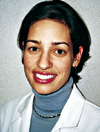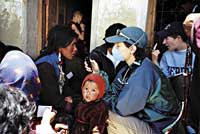The Education of Dr. Szlyk
High up in the Himalayas, a medical student learns to respect the limits of Western medicine.
Story and photos by Sonia Szlyk ’98

A crowd of more than 50 villagers surrounds me. My patient, Tsering Dolma, is a 27-year-old mother of two whose weathered face resembles that of someone twice her age. Both her children are tugging at my pants, chanting “One rupee? One rupee?” I pull out a sheet of stickers and watch their eyes dance as I let them select their favorite color stars. A commotion erupts as the other children rush to see the Western gifts. I keep my attention on the mother and begin working with my translator to elicit her chief complaint. We are sitting on folding chairs, on the rickety porch of a two-room schoolhouse. After a labored effort, the translator tells me, “Pain in her joints for the last 10 years.” I question further and learn that Tsering carries bricks, made from lake mud and dried in the sun, to villages in the mountains. I consult with one of the physicians on the team and review our pharmacy stock: Amoxicillin, multivitamins, ear and eye drops, antacids. I prescribe an anti-inflammatory. As the translator relays the prescription to Tsering, I feel unsettled. I know the most effective remedy would be for Tsering to rest from her labor. But here, at the top of the earth, medicine and culture clash.
As part of a volunteer medical expedition to Northern India, I spent last summer with a team of 13 physicians and students from across the United States. We delivered $250,000 worth of medical supplies and provided medical care to more than 500 natives of the Tibetan Plateau.
Tsering Dolma is one of those villagers. She lives at 15,500 feet above sea level in the Himalayan village of Puga, a barren, brutal land that suggests a moonscape. As I treated her, the conflict that faced me, as a second-year medical student, was as old as the Hippocratic oath. How can I tell this woman, who is struggling to feed her children, to stop her strenuous labor? How do I treat her as a whole person, and not just her illness? How could I possibly step into my patient’s world and make a valuable difference? I would soon discover that the most difficult part of this answer would be knowing where to begin—and when to stop.
My Western perspective was tested when a mother brought her children to me because they coughed and fainted at night. I learned that their one-room hut had no ventilation, and the smoke from the open fire, for cooking and warmth, was trapped in their home. She could open no window and she refused to keep the door ajar, fearing spirits would enter from the outside.

In other cases, people needed basic knowledge about human health. Mothers need to know that cutting a slit in the crotch of their child’s pants, allowing them to urinate and defecate nearly any time or place, increases the chances of sickness and infection. Several of the Buddhist monks whom I treated complained of headaches. By the end of our interviews, I realized that they read for more than 10 hours without taking a break to rest their eyes. When I asked one patient if he could clearly see the writing on a sheet of paper, he squinted and brought the paper to within an inch of his face. This monk, along with the more than 40 other monks I examined, needed reading glasses.
During the two-week expedition, I learned to accept my limitations as a health-care provider. Although I wanted desperately to help the monks, the mother who was afraid to open the door, and Tsering Dolma, I knew that modern medicine was no match against societal, economic, and cultural forces. I could provide reading glasses, yet several patients’ health problems were deeply intertwined with religious beliefs and practices. Rather than seeing myself descending upon an underserved culture and solving all their problems, I learned it is more valuable to acknowledge and appreciate their differences.
Bates, where one can do a thousand different things in one day, helped teach me flexibility in the face of uncertainty and difference. At George Washington and also at Bates, I learned to look at the bigger picture, to take a few extra minutes and ask myself, “What is the root of the problem, and how can I make a long-term impact?” Someday, if a patient comes to me with a tumor that’s impeding her ability to play an instrument, and I know the joy of playing music or the joy of listening to a great musician, I will have made a connection with that patient that transcends mere medical knowledge.
Yet, deciding when to intervene with medicine and when to let a patient’s beliefs guide their care is not an easy task, and cannot readily be understood through textbooks. Restraint—resisting the urge to mold the patient into modern medicine’s version of good health—comes with practice and the willingness to expose oneself to challenging patient populations. Several Tibetan villagers I saw in India had nothing physically wrong with them, yet they visited the medical tent simply to be touched by healing hands. We, of course, spent time with those patients—just taking their blood pressure or pulse delighted them because they had never before experienced a doctor’s care. In fact, their curiosity stemmed from wanting to understand us, not our medicine.
I now see the great value in this simple desire. At the heart of health care, no matter what the setting, is making a connection with the patient. In the case of Tsering Dolma, I cannot—nor should I—stop her from hauling bricks all day long to feed herself and her family. Listening to her story and respecting her beliefs can provide more healing than any medication that I could prescribe. In the end, that act transcends all cultural barriers.